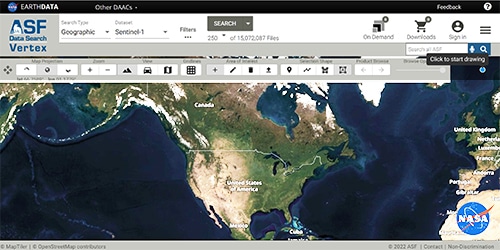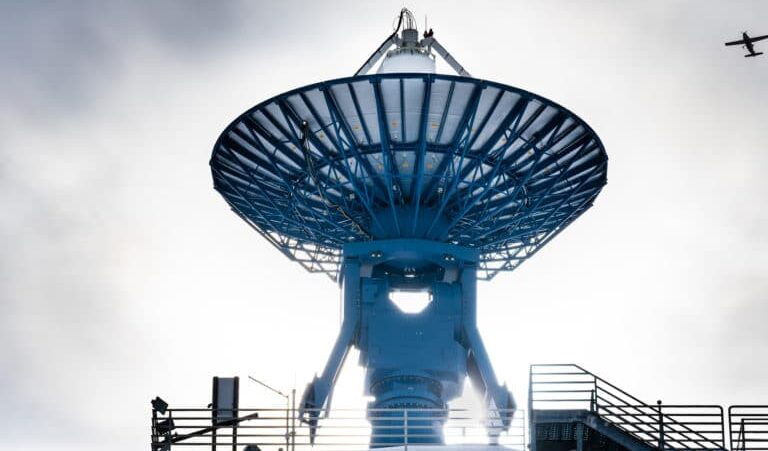Zhong Lu has a story about Syun-Ichi Akasofu, the groundbreaking aurora scientist and former director of the University of Alaska Fairbanks Geophysical Institute.
It’s a story that changed the career path of Lu, who is now chairman of the Alaska Satellite Facility NASA Distributed Active Archive Center Users Working Group.
It began, as Lu recounts it, with a story in the July 8, 1993, edition of the journal Nature, whose cover image referred to an article about a French research team’s use of interferometric synthetic aperture radar, InSAR, to show deformation caused by the June 1992 magnitude 7.3 Landers earthquake in California.
Ken Dean, research associate professor at the Geophysical Institute, had brought a copy of the journal to Akasofu and told him that the institute’s Alaska Satellite Facility collects the type of data the French had used. Akasofu inquired about the Geophysical Institute conducting similar research. It didn’t do it at the time.
Akasofu discussed the subject with faculty members, including Lu’s adviser, seismology professor Max Wyss, and said he would provide a research assistantship for graduate students interested in moving to this research direction.
Wyss brought Lu, then a seismology doctoral student, to his office one afternoon.
“ I still remember what he said: ‘The good part is that this is a new radar remote sensing technique that might have great potential, and the bad part is that you have to start from scratch.’”
Wyss was a seismologist, after all, and not a remote sensing scientist. He asked Lu to think about it, talk to family, and let him know his decision in a week.
“I told him right away that I would like to switch to this research direction,” he said.
Within weeks he began working with the Alaska Satellite Facility’s team to process SAR images, to develop the technique of using interferometric SAR and to apply it to volcano monitoring.
And so Zhong Lu seismology Ph.D. student became Zhong Lu remote sensing Ph.D. student.
•••
Lu was born in Wuchang, in China’s Heilongjiang Province. The province is in China’s northeast, bordering Russia’s Primorskiy administrative area.
Wuchang is located along the Wuyuer River, a tributary of the Songhua River, and is in an area known for its fertile soil and agriculture. Agriculture is a significant part of the local economy, with the cultivation of crops such as rice, soybeans and corn.
“We produce probably the best rice in the world,” he said.
Lu obtained his bachelor’s in geophysics at Peking University in 1989 and his master’s, also from Peking University, in 1992.
“I am the first person in my family who graduated from high school, and I’m the first person in the family that went to college,” he said. “And I think I was very fortunate in that I went to the best college in China, Peking University.
Soon Lu would be on his way to UAF.
“I landed on my feet on Sept. 18, 1992, a few weeks late because of the processing of my visa,” Lu said. “My intention was to study earthquakes and seismology.”
“I recall I was really fascinated with Alaska, because in that time there wasn’t much internet where you could look up things in advance, 1991. I was really fascinated by the wilderness and the beauty of Alaska.”
Alaska also had a lot to offer for a budding seismologist.
“There’s a lot of earthquakes and volcanoes,” he said. “And some are very close.”
Lu earned a Ph.D. in geophysics in 1996 after making the switch from seismology to remote sensing as a result of that July 1993 edition of the journal Nature.
•••
Today Lu is the Shuler-Foscue Chair professor Earth sciences at Southern Methodist University, where he has been since late 2013. He previously worked for the U.S. Geological Survey’s Cascades Volcano Observatory and earlier as fellow with the Science Applications International Corporation, a USGS contractor. He was a postdoctoral research associate at the UAF Geophysical Institute for seven months in 1996-97.
Lu specializes in a variety of InSAR uses, among them volcano deformation mapping, magma supply dynamics, land subsidence and infrastructure stability monitoring and characterization, coastal deformation analysis, hydrogeological models and landslide monitoring.
He also works in analysis of human-caused deformation from such processes as mining, carbon dioxide and wastewater injection and hydrocarbon extraction, for example.
Lu’s expertise is across two lines. One is finding new ways to process data to produce the results with high quality and precision, and the second is applying geophysical models to understand the causal mechanics of natural and anthropogenic geohazards.
“For example, if you want to study a volcano, we want to know the location of the magma reservoir and how much pressure changes inside the magma reservoir,” he said.
Volcanoes figured prominently in his early career, even leading to a 2014 book titled “InSAR Imaging of Aleutian Volcanoes”. Lu imaged all of the active volcanoes in the Aleutian Arc, a band approximately 1,800 miles long and today containing dozens of active volcanoes.
In the book, Lu notes the significance of interferometric synthetic aperture radar as an emerging remote sensing tool.
“With its global coverage and all-weather imaging capability, InSAR has become an increasingly important technique for studying volcanoes in remote regions such as the Aleutian Islands,” he wrote. “The spatial distribution of surface deformation data derived from InSAR images enables the construction of detailed mechanical models to enhance the study of magmatic processes.”
The research in that book came from his analysis of data previously archived at the Alaska Satellite Facility Distributed Active Archive Center. The center is one of NASA’s 13 Distributed Active Archive Centers and is the only one that archives synthetic aperture radar data.
“ I processed the data so I could see which volcanoes are doing what we call dancing, moving up and down, and determine the cause,” he said.
Lu has published numerous papers. Some of his most recent include the following:
| 2018 Paper | The use of radar imagery to identify an association between localized geohazards in West Texas and human activities. | Link to document |
| 2021 Paper | The use of satellite imagery to assess aging Permian Basin oil wells. | Link to document |
| 2022 Paper | InSAR mapping of rapidly deglaciating terrain in Glacier Bay National Park and vicinity. | Link to document |
| 2023 Paper | apping and characterizing land deformation over the Gulf Coast. | Link to document |
Those papers reflect an expansion of his work from volcanoes and into other geohazards such as landslides and coastal deformation.
Lu’s ambitions also go beyond Earth hazards. In June 2022, he was selected to NASA’s Venus SAR Science Team to study volcanism of Venus using radar images from the proposed EnVision mission.
“I like to teach,” he said. “I like to pass on the knowledge we learn to students. And I want to continue to do processing, but I want to expand the research.”
•••
His work will only accelerate when the joint U.S.-India NISAR satellite launches next year. The mission, a partnership between NASA and the Indian Space Research Organization, will greatly expand the amount of Earth science data available.
NASA has chosen the Alaska Satellite Facility to host the satellite’s enormous amount of data.
Lu is on NISAR’s Solid Earth Science Team, along with Franz Meyer and Simon Zwieback, both of the UAF Geophysical Institute.
“NISAR will give us a global perspective to show global tectonics, volcanoes, landslides,” he said. “But it’s not only for geohazards but also to study such subjects as glacier change in the context of climate change and how the ecosystem changes, for example. NISAR is a sensor that can address interdisciplinary scenarios.”
Rod Boyce is a science writer for the University of Alaska Fairbanks Geophysical Institute




